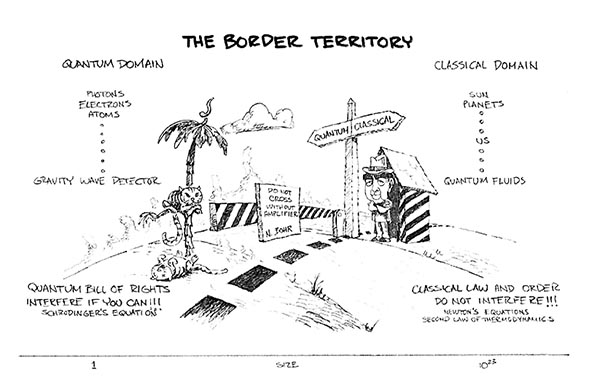A decade ago I did an ethnographic study of the little known, but highly promising, field of quantum information physics. I immersed myself in the work and world of physics: reading the field’s latest papers, attending the important conferences, interviewing the thought leaders, and taking thick notes on everything I saw and heard. After three years, when my notebook and brain were both filled with all cultural data they could carry, I wrote up my results, filed my doctoral dissertation, and sat back to wait for the scientific breakthroughs that I thought were soon coming, for the global information technology reboot that the field was on the verge of creating. I waited …and then I waited a bit more.

The Border Territory by Wojciech Zurek – Zurek’s imaginative view of the border between classical and quantum physics.
From the time I began my study, up until the time I left the field, quantum information physics went from nascent to booming. Much of the focus was on building a quantum computer, a device, they promised, that could make direct use of the quantum physics phenomena to represent data, as so-called qubits, and perform computational operations at speeds never before seen. Theoretically, a quantum computer would be able to find the prime factors of any integer instantaneously. This capability would allow a quantum computer to decrypt in a short time all of the public key ciphers that are currently used to protect bank transactions, embassy transmissions, personal and government email, Web pages, and any other secure digital data. A quantum computer, they insisted, would change the world. In the wrong hands, it had the potential to shift global political power dynamics by decrypting government secrets (both old and new), steal vast sums of money, or engage in other kinds of electronic chicanery. In the right hands, however, it could make data transmission in our digital world impossibly secure.
After I finished my research, I was less present in the field, but followed it passively, knowing that when the quantum computer was born, I’d see the birth announcement on every news channel and science news website on the Internet. But nothing came. Well, not exactly nothing. In 2012, David Wineland, one of the thought leaders in the group of physicists I studied, snared the Nobel Prize in Physics “for ground-breaking experimental methods that enable measuring and manipulation of individual quantum systems.” That was very much a something. Still, the world and I were still asking, “Where is my quantum computer?”
As of 2014, quantum computing is still in development and breakthroughs are pending. Government and military funding agencies continue to support quantum computer research and a few more groundbreaking experiments have been carried out doing small quantum computational operations on a small number of qubits, but a quantum computer is still just around the corner. So what happened to the breakthroughs that I was awaiting? Was my experience in the field all just smoke and mirrors for the dubious benefit of a nosy social scientist peering over the shoulders of “real” scientists and taking notes? I doubt it.
I believe this is example of how the practices of scientific discovery and technology development are truly unpredictable. The excitement I witnessed in the field a decade ago was palpable and real and the physicists I knew were indeed breaking new theory ground. Maybe at heart none of them really expected to see a quantum computer by 2014, but I know they were hoping for one. Today they have a field that is strong and active, one that can even claim a Nobel Prize as its own, but the work still seems no closer to changing the world than in 2004.
As I look backward and forward at this situation, it seems like a good opportunity to return to the field in order to practice the kind of extended participant observation that Kemper and Royce explored in Chronicling Cultures: Long-Term Field Research in Anthropology (2002). Although the needs of corporations, medical anthropology, and user experience (UX) design studies are even now pushing the use of new “quick ethnography” or “rapid ethnography” methods, the conventions and traditions of long-term ethnographic study remain significant to me. Geertz’s “thick description” (1973) still has value to me in explicating complex aspects of culture. Obviously, the evolution of quantum information physics continues but may not reach its goals even in my lifetime, or perhaps ever. Questions abound for me about the continuing value of studying a field that seems to have just as much chance of changing the world as it does fading into obscurity. I could return to the field, but until that time I remain a hopeful watcher of a field on the verge of a scientific breakthrough…now ten years and counting.
Geertz, Clifford. 1973. The Interpretation of Cultures
Kemper, Robert and Anya Peterson Royce. 2002. Chronicling Cultures: Long-Term Field Research in Anthropology.

2 Comments
This is a strange inversion of how I feel about my fieldwork around the game industry. I feel like it’s constantly shifting and moving… Yet, the conclusion is actually the same. That having a cultural analyst sticking around for the long term is hugely valuable. I haven’t read the Rober and Royce piece you mention, but I will now.
Next week I’ll be posting some reflections on ten years worth of notes on the Game Developers Conference, so the timing of your post is right in line with that. 🙂
I do wonder about the nature of the goal of quantum information physics. From an outsider’s point of view, the non-appearance of the quantum computer suggests a failure, or a false trail. From an insider’s point of view, it may be the case that lots of interesting physics continues to be done. Perhaps the quantum computer has been the outward facing story of why the research should be funded, rather than the actual goad.
2 Trackbacks